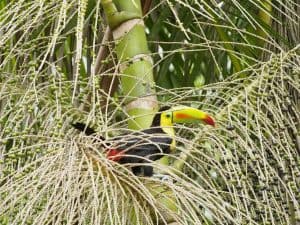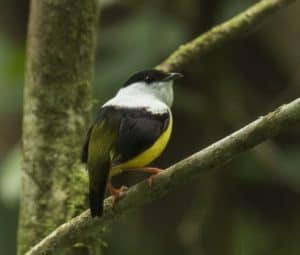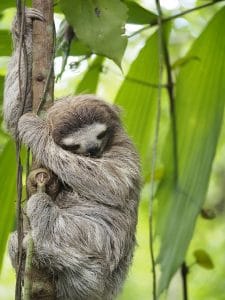Wildlife in Costa Rica can almost seem other-worldly: toucans with rainbow-colored beaks nearly as big as their body; huge Blue Morphos cruising about like computer-generated butterflies from the movie Avatar; and, as I’ll describe this week, wing-snapping manakins leaping back and forth like frenzied ping-pong balls. This amazing offering of the natural world was why my wife and I, along with our friends Mike and Sonja Barker, had decided to spend four weeks this winter in Puerto Viejo on the country’s southern Caribbean coast.
Despite the large number of tourists – the vast majority in their 20s and 30s – Puerto Viejo still has a gritty, grassroots vibe. This comes courtesy of Afro-Costa Ricans with their dreadlocks and Rasta hats; beat up ‘pirate’ taxis and three-wheeled tuk-tuks ferrying customers; reggae and hip hop music emanating from streetside bars; the aroma of rice and beans wafting from Caribbean restaurants; rickety fruit and vegetable stands spilling over with a dizzying array of product; and, more often than not, the skunky smell of marijuana on the evening breeze. There’s not a fast-food chain restaurant to be seen anywhere and, so far, local activists have been able to protect the area from large resorts and condominium complexes.
Manakins
As I outlined last week, the house we rented at Finca Loco Natural provided a non-stop parade of large, flamboyant tropical birds and mammals. One of the most common and fascinating species, however, was also the hardest to see. For the first couple of days, we wondered what in the world was making a non-stop snapping sound – reminiscent of someone banging stones together – emanating from the shrubbery. Pamela, our accommodating host, provided the explanation. The mystery sound was courtesy of the White-collared Manakin, a plump, chickadee-sized bird that is a master of concealment. Like other manakins, this species puts on a highly amusing but hard-to-observe mating dance. It all happens in an area known as a ‘lek’. To create the lek, the male removes all of the leaf litter and vegetation from a patch of forest floor under a dense stand of shrubs. When a female is lured to the area, he leaps back and forth at high speed between the stems of the shrubs. Each time he leaps, he snaps his wings, thereby creating the loud sound. Sometimes two males jump together, crossing each other above the bare soil. This was happening right beside our house! Only by going up on the balcony and peering down from above were we able to observe the spectacle. The manakin’s dance is an intriguing example of how evolution through natural selection – the females, in this case, doing the selecting – can drive male breeding behaviour to the most outrageous extremes. Go to bit.ly/2qAHEd5 to see a great YouTube video.
Abel and Alex
By far the best way to appreciate Costa Rica’s incredible biodiversity is to hire a guide. Costa Rican guides are highly trained and actually licensed by the government. With Abel Bustamante, I spent a morning exploring part of the wonderful Gandoca-Manzanillo Wildlife Refuge, located a short distance southeast of Puerto Viejo. His unbridled enthusiasm and energy were contagious. If you ever want a reluctant friend or spouse to discover the joys of birding, an outing with Abel will do the trick. Thanks largely to his knowledge of bird song, I was able to add nearly 20 new species to my life list – everything from Fasciated Ant-shrike and White-ringed Flycatcher to Pied Puffbird and Snowy Cotinga. Together, we also marvelled at a flock of 30 or more Swallow-tailed Kites migrating overhead.
On another occasion, I returned to the Kekoldi Hawkwatch tower with a second indigenous guide, Alex Paez. The native guide I’d gone with originally, Kesh Hernandez, was fully booked that day. Only minutes up the trail, Alex’s sharp eyes spotted a small sloth, almost at eye level. Alex explained that sloths make a weekly, slow-motion descent from the treetops, dig a hole in the ground, defecate and then cover their scat. Why they go to all this trouble remains a mystery. Sloths may have algae growing on their fur, but at least their bathroom manners are impeccable! Although the raptor-viewing from the tower was slow that day, peering down on the rainforest canopy from above did produce other new species for me such as a pair of beautiful Black-crowned Tityras.
A few days later, I did a rainforest night hike with Alex and his eight-year-old son. I had only seen one snake and relatively few frog species on the trip and wanted to see more. Sporting headlamps, we inched our way along a muddy path, peering under huge Heliconia leaves, inspecting roots and vines, watching for the reflection of distant eye shine. Thanks in no small measure to the eagle eyes of Alex’s son, we found two species of snakes, nine kinds of frogs, five Emerald Basilisk lizards, roosting Great Owl butterflies and countless moths, spiders and fireflies. I was able to take great photographs of a Masked Treefrog as it posed beside red and yellow Heliconia flowers; a Red-eyed Leaf Frog – the iconic Costa Rica T-shirt species – which actually jumped onto my shirt pocket; a beautifully camouflaged but highly venomous Fer-de-Lance snake, curled up in the roots of a tree; and a Blunt-headed Tree Snake, which was almost identical in length, shape and colour to the vines in which it moved. These latter three species were exactly those I was most hoping to find.

Red-eyed Leaf Frog photographed on a rainforest night hike. Note the blue side pattern (Drew Monkman)
Conservation
Over the course of our stay, we visited a number of conservation initiatives. One of the most interesting of these was the Jaguar Rescue Center. Its raison d’être is the rehabilitation of mistreated, injured, orphaned, and/or confiscated birds and mammals. Those animals that can be successfully rehabilitated are then reintroduced into their natural habitat in a nearby protected area. The Center is a great place to get close up views of sloths, monkeys, snakes, ocelots, toucans and parrots and learn from the knowledgeable, enthusiastic guides.
We also spent a wonderful afternoon at the Manzanillo field station of the Ara Project. The Project’s goal is to re-establish a breeding population of Great Green Macaws in the southern Caribbean region. The station is located high up on the mountain side where it offers spectacular views of the surrounding forest and ocean. The highlight, however, was seeing the macaws themselves. Almost three feet in length and garbed in green, blue and white, it was heart-lifting to see these birds flying free once again over Caribbean lowland forest. Volunteers offer supplemental feeding to the macaws and maintain nesting boxes.
I was also encouraged to learn that conservation initiatives extend beyond just birds and mammals. Alejo Pacheco, who I met one morning while out birding, is working hard to promote snake conservation. Sadly, the habit of killing snakes on sight is still the norm in Costa Rica. Increasingly, however, when people encounter a snake on their property, they call up Alejo, who catches and relocates the animal. Mike and I were able to accompany Alejo on the release of a metre-long Fer-de-Lance. The three of us squeezed into the front seat of his old truck and drove down to the end of deserted dirt road. Before releasing the snake, he held it briefly in his hand, allowing us to get a great look at the fangs and beautifully patterned skin. Rest assured that there are only about seven snake deaths per year in Costa Rica. Driving is far more dangerous!
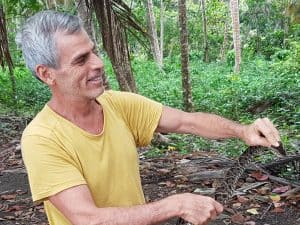
Alex Pacheco holding a venomous Fer-de-lance. Alejo is a champion of snake conservation in Costa Rica – Drew Monkman
Alejo has the friendly personality that is typical of so many Costa Ricans. He is also the owner of beautiful tourist houses such as Casa Balto and Casa Yacky, which he rents out. Perched high on a mountainside, they not only offer spectacular views but the surrounding area is also incredibly rich in bird life.
Chocolate
No account of Puerto Viejo would be complete without mentioning chocolate. The area has half a dozen local bean-to-bar chocolate makers. To learn more, we did an exceptional tour with Caribeans. They have been successful in rehabilitating a cacao plantation, which was abandoned in the 1980s after a deadly fungus struck. The highlight of the tour was sampling four kinds of local chocolate in pairings with coconut, garlic, curry and a wide array of spices. The tasting took place on a mountainside balcony with a stunning view of the ocean and rainforest. I later learned a great deal about the significant health benefits of cacao from Sandra Candela, a woman I met with for Spanish conversation. From Sandra, I learned a great deal about climate change in the south Caribbean region as well as birds, trees, cacao production and the importance of cacao farming to indigenous peoples. Sandra also produces and sells dehydrated, raw cacao beans which she markets under the name RaWo She explained to me that raw cacao is thought to be the highest anti-oxidant in nature.
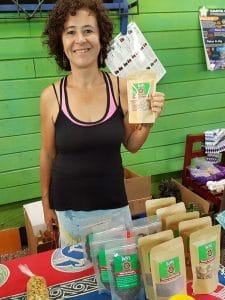
Sandra Candela is a wonderful Spanish teacher. She also dehydrates raw cocoa beans, which she sells at the Puerto Viejo Saturday morning Farmers Market – Drew Monkman
Climate change
Like everywhere, Costa Rica’s Caribbean coast is grappling with climate change. The area is seeing an increased number of tropical storms, hurricanes and heavy rains. Sea level, too, is rising and destroying coastline. We saw this at Cahuita National Park where coastal erosion has eaten away at beaches and numerous trees have fallen. Warmer water temperatures and increased acidity have also damaged coral ecosystems. Disruptions in the climate are making life more difficult for indigenous farmers, as well. As Alex Paez explained to me, seasonal weather differences are now far less clear, which results in confusion about when to plant crops.
Despite these challenges, the southern Caribbean coast of Costa Rica remains a wonderful place to visit and to experience nature at its most diverse. Personally, I can’t wait to go back. Next week, I’ll conclude this series with some highlights from our stay in San Isidro de Heredia where we spent the final 10 days of the trip.
